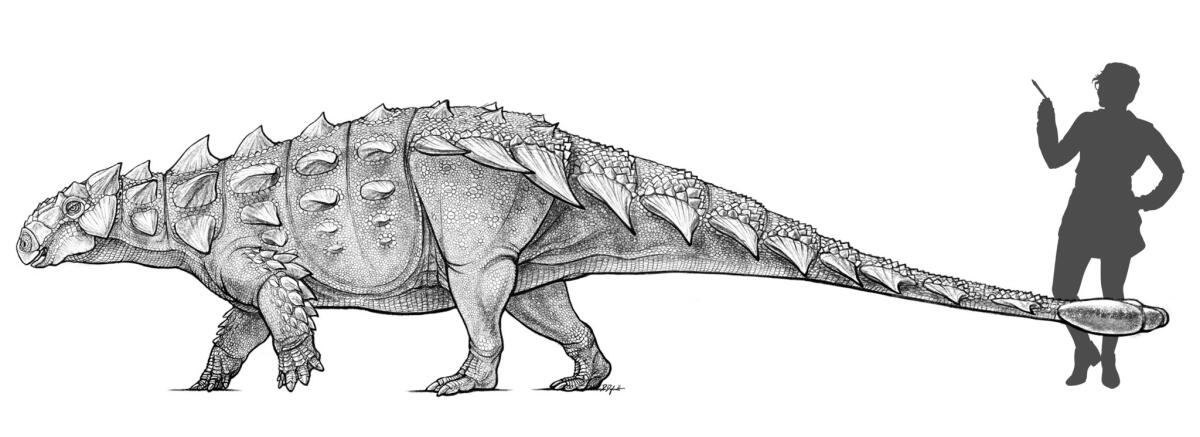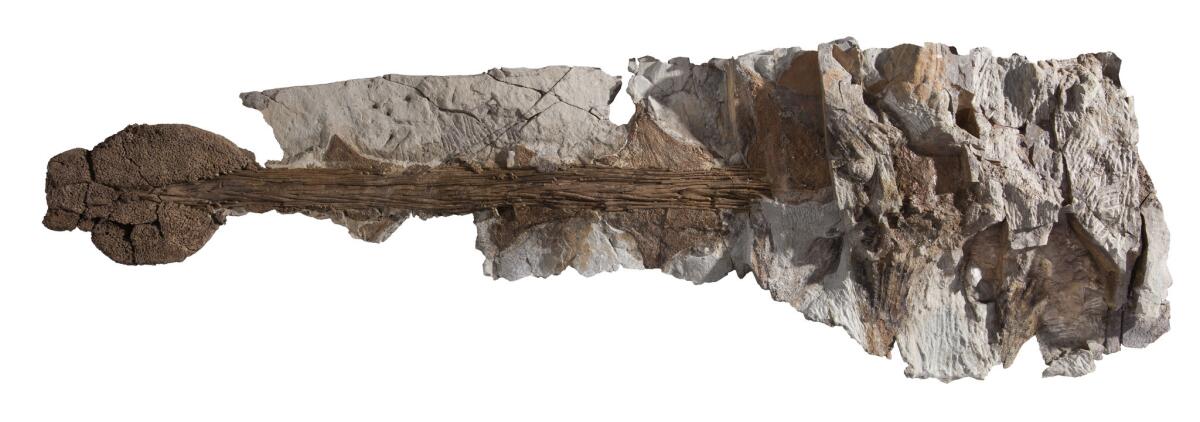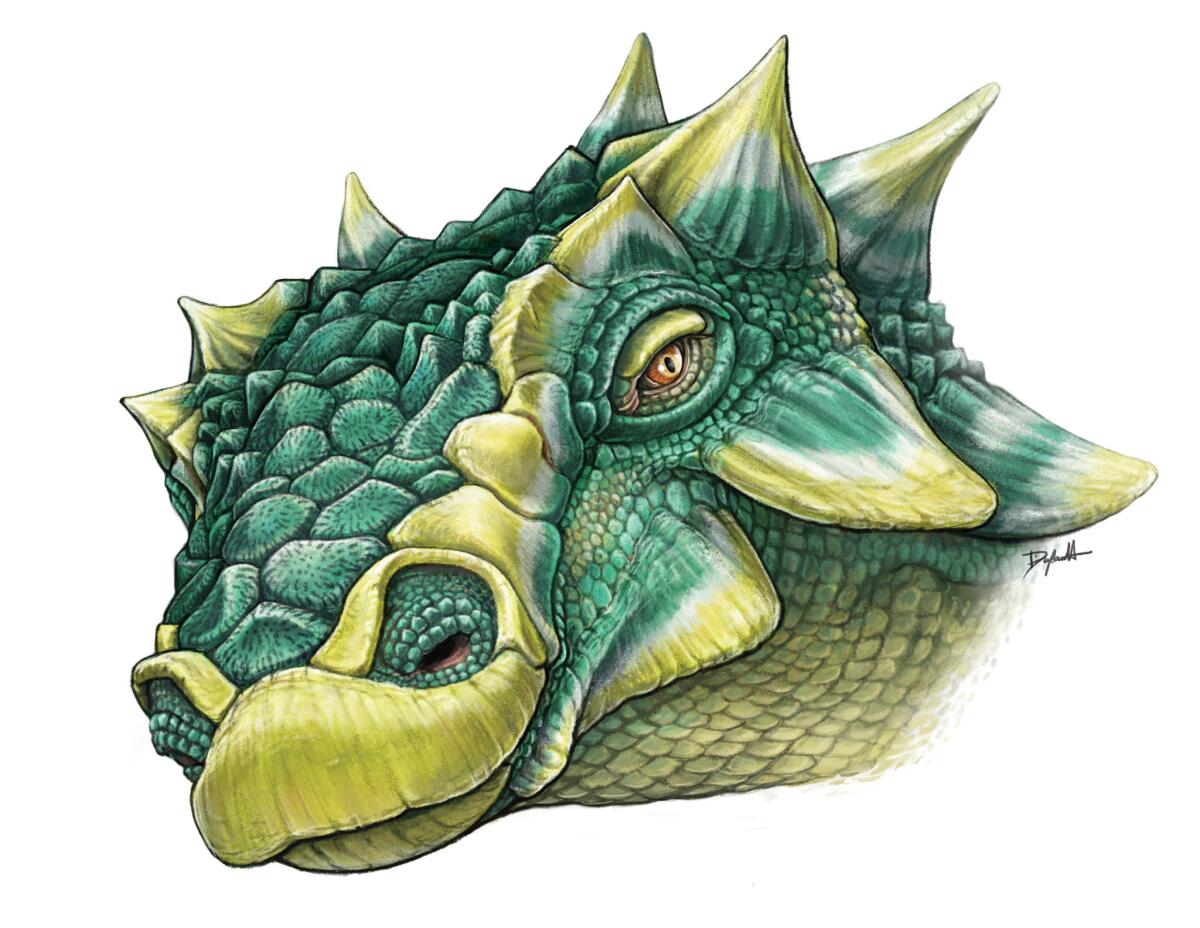Dinosaur named for ‘Ghostbusters’ creature found in Montana 75 million years after its death

Meet Zuul crurivastator, a dinosaur discovered in Montana that shares a strong resemblance to Zuul, the “terror dog” character in the movie “Ghostbusters.” He is introduced by Dan Akryod, who played Ghostbuster Ray Stantz in the 1984 movie.
Someone call the Ghostbusters: Scientists have discovered a new species of horned, club-tailed dinosaur with a spooky resemblance to the monstrous demigod Zuul, one of the villains of the 1984 movie.
The ankylosaur, described in Royal Society Open Science, could shed light on the surprising diversity of these creatures near the end of the age of dinosaurs.
Zuul crurivastator’s scaly body stretched some 20 feet long, with an impressive tail that took up half that length. Its tail was lined with forbidding spikes and ended in a sledgehammer-like club. Two horns sat on its skull right behind the eyes, giving it a very Zuul-like look that inspired the genus name.

As big as a rhino, but with more spikes
Z. crurivastator weighed in around 5,500 pounds, which is about the size of a white rhinoceros, said study leader Victoria Arbour, a paleontologist at the Royal Ontario Museum in Toronto.
Fearsome as it may look, this dinosaur was a plant eater that roamed present-day northern Montana some 75 million years ago. This specimen was discovered while scientists were digging up another dinosaur and a bulldozer apparently encountered the ankylosaur’s tail. (A small fragment came off in the process but was easily reattached later, Arbour said.)
Complete fossils of ankylosaurs are, for some reason, very difficult to find. Like a coin toss, these specimens basically appear to produce either heads or tails — but not both at the same time.
“You get, like, an OK tail but a little scrap of the skull, or a pretty nice skull and a little scrap of the tail,” Arbour said.
The fact that this specimen has such a complete skull and tail makes it a rare discovery. The size and shape of the strange spikes along the tail and the ornamentation on the skull help mark it as a novel ankylosaur species.
A Rosetta stone for dinosaurs
And the fossil has been so well preserved — perhaps buried in sediment soon after it died — that researchers even found soft tissue, including scales and sheaths for the spikes. Because the soft tissue was so well preserved, the spikes were held together in their original placement.
“It keeps those bony spikes in place all the way down the tail, so we have a really good idea of what it would have looked like while it was alive,” Arbour said. “It kind of is like a Rosetta stone for interpreting isolated spikes when we find them when we’re just walking around the badlands.”

Like their relatively close cousins the stegosaurs, ankylosaurs may have used their weaponized tails to fend off predators such as tyrannosaurs: The species name crurivastator means “destroyer of shins.”
It’s also possible that the dinosaurs used their tails to compete with other males, though it’s hard to test that theory in an extinct species, Arbour noted.
“We know that other ankylosaurs could swing their tails with a lot of force, enough force to break bone,” she said. “But they were really well-adapted for absorbing those forces so they wouldn’t break themselves.”
A surprising diversity of dinosaurs
Scientists once thought North America was home to just one or two species of ankylosaur, but this new specimen adds to the growing body of evidence that there were far more of these hammer-tailed species than previously thought.
“That kind of matches up a bit more with what we see in the horned dinosaurs and the duck-billed dinosaurs, where there’s really high species diversity in the twilight of the age of dinosaurs,” Arbour said. “So they were doing really well at that period ... and this particular dinosaur filled in a little bit of a gap in that record.”

The paleontologists haven’t yet fully extricated the fossil from the large hunks of rock they brought back to the lab; that process could take a couple of years, Arbour said.
In the meantime, they hope to examine the fossil’s soft tissues to learn about its biochemistry and perhaps identify molecules like keratin or collagen, the kinds of compounds found in fingernails or skin.
“We’re also going to be studying some of the other fossils that were found in the same quarry as this ankylosaur,” Arbour added. “We’ve got great fossils of turtles and crocodiles and other dinosaurs and plants and clams and snails, so we’re hoping to be able to flesh out the ecosystem that Zuul lived in as well.”
Follow @aminawrite on Twitter for more science news and "like" Los Angeles Times Science & Health on Facebook.
MORE IN SCIENCE
Scientists are on alert after the latest changes at the EPA
To live a long life in America, it helps to be born in the right county
Another way humans are polluting the environment: Too much noise




